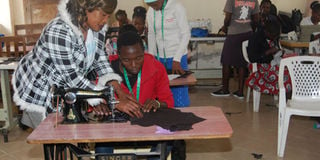More women are pursuing technical courses in Nakuru

A dress making lesson at Nakuru Vocational Polytechnic. PHOTO | FRANCIS MUREITHI | NATION MEDIA GROUP
What you need to know:
Education experts say with more women joining TVETs poverty and unemployment in the county will be addressed.
At least 2,000 students seek admission to various institutions in the county every year.
The population of females pursuing Technical and Vocational Education Training (TVET) courses in Nakuru County has surpassed their male counterparts by more than 1,700.
This comes at a time when more women in the cosmopolitan county are seeking to be self-reliant in the male dominated job market.
UNEMPLOYMENT
Education experts say with more women joining TVETs, poverty and unemployment in the county will be addressed.
“Most of the women taking the courses seek to be self-employed after completing their courses,” said Nakuru County Director of Vocational Training David Mwangi.
According to the population and housing census carried out by the Kenya National Bureau of Statistics, 13,049 females are engaged in one or two courses.
The male population is 11,283 which makes the total population in TVET institutions in the county to be 24,332.
Nakuru County has a total of 68 registered TVETs out of which 40 are private while 28 are managed by the devolved unit. At least 2,000 students seek admission to various institutions in the county annually.
All the 10 sub counties have more females in TVETs except Subukia whose population of females is 282 against 342 males.
342 MALES
Gilgil Sub-County has a near balanced ratio of students of 1,029 females and 1,031 males.
Naivasha Sub-County has the highest number of females at 2,107 while males are 1,882 bringing the total population to 3,989.
Nakuru East, which has some of the pioneer institutions in the county, has a population of 3,976 out of which 2,271 are females and males are 1,705.
Nakuru West, which is increasingly becoming the next hub of vocational and technical training in the county, has revamped its institutions that has led to an increase in student population in the region.
The fair disbursement of National Government Constituency Development Fund has also attracted a population of 3,387 students with female taking the lion share at 1,908 and male are 1,479.
SHOLARSHIPS
Nakuru North, which has launched a campaign to sponsor more students in the institutions, has a population of 2,582 made up of 1,428 females and 1,154 males.
Rongai Sub-County has a population of 2,473 with females leading at 1,285 against 1,188 males.
Njoro Sub-County, which has revived dormant institutions, has a population of 850 females and 781 males making it a total of 1,631.
Molo Sub-County has a population of 1,288 out of which females are 693 and males are 595. Kuresoi South has a population of 1,271 with a female population of 667 and males are 604.
Kuresoi North is last with a total of 1,051 students (529 females and 522 males).




